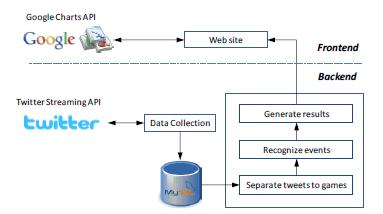| Twitter as realtime sports reporter |
| Written by Mike James | |||
| Saturday, 25 June 2011 | |||
|
Can people be used as a "sensor net" to detect when important events happen? When it comes to sporting events it seems that all you have to do is look to the Twitter frequency. The big thing for the near future is the Internet of Things but a group of researchers at Rice University (Houston) think that we are being a bit narrow in the meaning of the term "thing". To quote from their paper: "The global human population can be regarded as geographically distributed, multimodal sensors" That is, if you want to know what is going on just ask a human. But How? One answer, and the one explored in the recent work, is to use the Twitter Firehose. This represents the output of supposedly 200 million humans publishing 140 word tweets whenever something even mildly interesting occurs (and far too often when nothing at all interesting happens). The basic idea is to use tweets as an indication of what is going on in the world: "While many have demonstrated Twitter can provide insights into major social and physical events like earthquakes [1], celebrity deaths [2], and presidential elections [3], in this work, we answer a much tougher question: how good is Twitter at real-time sensing for less significant but more frequent events such as what happens in a sport game?" If you contemplate the task you will see that it isn't easy. The first problem is to find the tweets that relate to sport and a particular game. You might think that this is just a matter of filtering on hashtags but only 11% of all tweets have any sort of hashtag. So there is no choice but to process the body of the tweets and the good news is that 60% of tweets about a game actually mention the name of the team. By looking for keywords describing events - touchdown, interception and so on - and by measuring the tweet frequency they can pin down the moment a significant event occurs.
The system that they created seems to work for most games. The exception to this is the Super Bowl for the reason that the sheer number of tweets about the game saturated the Twitter distribution system and so they couldn't pick out the maximum in tweet frequencies. The web service that they created used Amazon's EC2 and Google Charts to present the result. Notice that this isn't an exercise in artificial intelligence - more in straightforward real-time statistics.
They also discovered some other strange pieces of information. For example, it takes 17 seconds for an event to be tweeted and mobile devices join in after about two seconds - presumably because text entry takes longer. Twitter's streaming API also delivers up tweets with popular keywords and hashtags in about one second but tweets with less common tags take up to 30 seconds. Where next? If you add on an AI backend you could process the tweets to provide a sports commentary in real-time. You might even be able to convert unexpected events into a real-time news feed - but this is all much more difficult than using tweet frequency to spot when a touchdown happens. More InformationHumans as Real -Time Sensors of Social and Physical Events (pdf)
|
|||
| Last Updated ( Saturday, 25 June 2011 ) |


